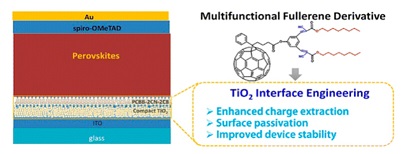Yaowen Li*†‡, Yue Zhao†, Qi Chen‡, Yang (Michael) Yang‡, Yongsheng Liu‡, Ziruo Hong*‡, Zonghao Liu‡, Yao-Tsung Hsieh‡, Lei Meng‡, Yongfang Li*†, and Yang Yang*‡
† Laboratory of Advanced Optoelectronic Materials, College of Chemistry, Chemical Engineering and Materials Science, Soochow University, Suzhou 215123, China
‡ Department of Materials Science and Engineering, University of California, Los Angeles, California 90095, United States
J. Am. Chem. Soc., 2015, 137 (49), pp 15540–15547
In perovskite based planar heterojunction solar cells, the interface between the TiO2 compact layer and the perovskite film is critical for high photovoltaic performance. The deep trap states on the TiO2 surface induce several challenging issues, such as charge recombination loss and poor stability etc. To solve the problems, we synthesized a triblock fullerene derivative (PCBB-2CN-2C8) via rational molecular design for interface engineering in the perovskite solar cells. Modifying the TiO2 surface with the compound significantly improves charge extraction from the perovskite layer. Together with its uplifted surface work function, open circuit voltage and fill factor are dramatically increased from 0.99 to 1.06 V, and from 72.2% to 79.1%, respectively, resulting in 20.7% improvement in power conversion efficiency for the best performing devices. Scrutinizing the electrical properties of this modified interfacial layer strongly suggests that PCBB-2CN-2C8 passivates the TiO2 surface and thus reduces charge recombination loss caused by the deep trap states of TiO2. The passivation effect is further proven by stability testing of the perovskite solar cells with shelf lifetime under ambient conditions improved by a factor of more than 4, from ∼40 h to ∼200 h, using PCBB-2CN-2C8 as the TiO2 modification layer. This work offers not only a promising material for cathode interface engineering, but also provides a viable approach to address the challenges of deep trap states on TiO2 surface in planar perovskite solar cells.

链接://pubs.acs.org/doi/10.1021/jacs.5b10614